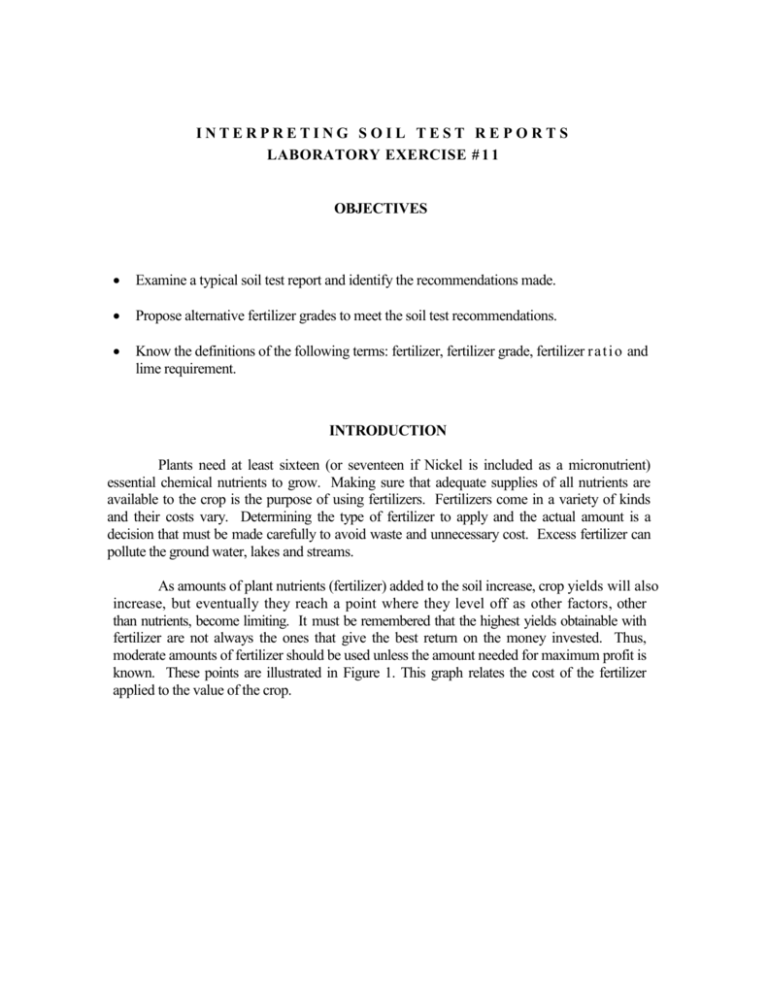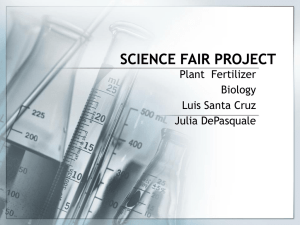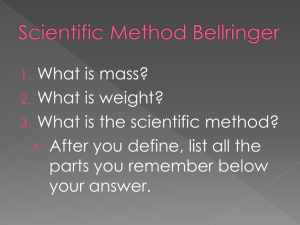Lab 11
advertisement

INTERPRETING SOIL TEST REPORTS LABORATORY EXERCISE # 1 1 OBJECTIVES Examine a typical soil test report and identify the recommendations made. Propose alternative fertilizer grades to meet the soil test recommendations. Know the definitions of the following terms: fertilizer, fertilizer grade, fertilizer r a t i o and lime requirement. SINTRODUCTION Plants need at least sixteen (or seventeen if Nickel is included as a micronutrient) essential chemical nutrients to grow. Making sure that adequate supplies of all nutrients are available to the crop is the purpose of using fertilizers. Fertilizers come in a variety of kinds and their costs vary. Determining the type of fertilizer to apply and the actual amount is a decision that must be made carefully to avoid waste and unnecessary cost. Excess fertilizer can pollute the ground water, lakes and streams. As amounts of plant nutrients (fertilizer) added to the soil increase, crop yields will also increase, but eventually they reach a point where they level off as other factors, other than nutrients, become limiting. It must be remembered that the highest yields obtainable with fertilizer are not always the ones that give the best return on the money invested. Thus, moderate amounts of fertilizer should be used unless the amount needed for maximum profit is known. These points are illustrated in Figure 1. This graph relates the cost of the fertilizer applied to the value of the crop. Figure 1: Relationship among rate of fertilizer addition, crop yield increase, fertilizer costs, and profit from adding fertilizers Note that the maximum profit for this soil and crop occur at 1100 kg of fertilizer added per hectare while the maximum yield of this crop would occur at approximately 1500 kg of fertilizer added per hectare. Lower and higher applications decrease profit and the value of the increased yield. Although curves such as Figure 1 would be useful for individual farms, they vary from year to year and field to field. The best that can be done at this time is for producers to utilize soil testing services to determine the amount of nutrients available to plants. The soil testing lab can then make recommendations as to how the farmer can raise the nutrient levels to increase yields with economical applications of fertilizer and lime. INTERPRETING SOIL TEST REPORTS The Soil Test Report has 4 blocks of information for each soil sample. They are as follows: 1. Field Information 2. Laboratory soil “Test Results” 3. Plant nutrient “Treatment for First Crop” 4. Plant nutrient “Treatment for Second Crop” FIELD INFORMATION The field information is data supplied by the fanner. This information helps the Soil Test Laboratory make a better recommendation. Be sure to specify the crop clearly. Do not write “beans” for soybeans. Soybeans do not require nitrogen, whereas snap beans do. TEST RESULTS The numbers in the blocks for P-I, Mn, Zn, and Cu are index values obtained from a chemical test. Index values are related to crop yield. If the index value is 25 or less (low range), the nutrient should be added to the field as a fertilizer. “Ac” is an index of potential acidity (H+ and Al3+ on the clay) and is used to calculate the lime requirement or the amount of lime needed to increase soil Ph to a desired level. Table 1 shows the relationship between index values and expected crop response to applied nutrients. More information on this subject is available on the back of the SOIL TEST REPORT sheet. Index Range 0-25 Low 25-50 Medium 50-100 High Potential for Crop Response to Fertilizer High Medium Low Table 1: Soil test index values TREATMENTS FOR NEXT TWO YEARS The second line of the soil test report has fertilizer and lime suggestions for the next 2 years. To help you understand this information the following discussion on fertilizers and lime is provided. A fertilizer is any substance that is added to the soil (or sprayed on to plants) to supply those chemical elements required for plant growth. Most fertilizers are used to resupply the soil with essential nutrients, especially nitrogen, phosphorus, and potassium. The amount of N, P, and K in the fertilizer is called the fertilizer ratio. A shorthand way of expressing the amount of N, P, and K uses 3 numbers separated by dashes, for example 3-6-9 (Figure 2). The first number represents the % nitrogen (N), the second number the % P2O5, and the third number is the % K2O. SUPER DUPER DOES IT ALL FERTILIZER 3-6-9 3% N, 6% P2O 5 , 9% K 2O Don’t try to grow your plants without it!!! Figure 2: Sample fertilizer bag The fertilizer grade is the relative amounts of N, P2O5, and K2O in the fertilizer. The fertilizer ratio is determined by dividing each number of the fertilizer grade by the smallest number present. For example, for the fertilizer grade 3-9-12, the fertilizer ratio would be 1-3-4 (i.e., 3/3 – 9/3 – 12/3). The fertilizer ratio is used to select a fertilizer material containing appropriate relative amounts of nutrients that will be applied to satisfy crop nutrient recommendations. The amount of lime that must be added to raise the soil Ph to a level suitable for the crop is termed the liming requirement. The Ph of a lime must be taken into account in making a recommendation because limes vary in their ability to neutralize acidity. LABORATORY EXERCISE – FERTILIZER CALCULATIONS Using the sample Soil Test Report provided at the end of this lab, answer questions 1-11 for soil sample CRN (corn), questions 12-17 for soil sample SYB (soybean), questions 18-23 for soil sample TOB (tobacco), and 24-27 for TEE (golf turf) on the soil test report. You will also need the information provided in Table 2 for calculating fertilizer costs. Mixed Fertilizers 1-1-1 1-1-1 1-2-2 1-2-2 1-3-3 1-2-3 1-2-3 1-1-3 1-3-6 1-3-6 FERTILIZER MATERIALS Diammonium phosphate Sodium potassium nitrate Potassium nitrate Anhydrous ammonia Ammonium nitrate Ammonium nitrate limestone 30% nitrogen solution Sodium nitrate Urea Superphosphate Concentrated superphosphate Muriate of potash (KCI) Sulfate of potash (K2SO4) Dolomitic limestone Calcitic limestone RatioAnalysis 8-8-8 10-10-10 5-10-10 10-20-20 3-9-9 4-8-12 6-12-18 8-8-24 3-9-18 4-12-24 18-48-0 15-0-14 13-0-44 82-0-0 34.5-0-0 20-0-0 30-0-0 16-0-0 45-0-0 0-20-0 0-46-0 0-0-60 0-0-50 Table 2: Fertilizer costs – (costs vary greatly due to transporation) Cost/ton $130.00 $145.00 $131.00 $207.00 $153.00 $163.00 $207.00 $230.00 $150.00 $215.00 $279.00 $198.00 $280.00 $200.00 $162.00 $125.00 $119.00 $156.00 $180.00 $132.00 $246.00 $159.00 $252.00 $22.00 $18.00 SOIL SAMPLE: CRN 1. How much lime is needed? 2. How much N is needed? 3. Why is a range of N additions given? 4. How much P2O5 is needed? 5. How much K2O is needed? 6. What is the ratio of N-P2O5-K2O? 7. If a 10-10-10 mixed fertilizer is used, how much is needed? 8. How much extra P2O5 and K2O are applied in the 10-10-10? 9. How much of the following high analysis fertilizers should be used? a. NH4NO3 (34.5-0-0) b. Urea (45-0-0) c. Anhydrous ammonia (82-0-0) d. Muriate of potash (0-0-60) e. Concentrated superphosphate (0-46-0) f. Ordinary superphosphate (0-20-0) 10. What is the cost of using only 10-10-10? 11. What is the cost of using ammonium nitrate? SOIL SAMPLE: SYB 12. How much N is needed for soybeans? 13. How much lime is needed on the soybean field? 14. What type of lime should be used (dolomitic or calcitic)? 15. If your lime had a neutralizing value of 75%, how much should be added? 16. How many pounds of muriate of potash are needed and what is the cost? (note: muriate of potash is KCl, whereas potash is K2O). 17. What is the pH of the soil? SOIL SAMPLE: TOB 18. If 10-10-10 is used, how much is needed? 19. What is the cost of the 10-10-10 needed? 20. How much extra P2O5 is added to the soil? 21. If urea and muriate of potash are used, how much of each is needed? 22. What is the cost of the urea and potash needed? 23. If anhydrous ammonia is used, how much is needed? SOIL SAMPLE: TEE (note that recommendations are given in tons/1000 sq. ft.) 24. How much lime is needed? 25. How much P2O5 is needed? 26. How much concentrated superphosphate would need to be applied? 27. How much K2O is needed? STUDY QUESTIONS 1. Define fertilizer, fertilizer grade, fertilizer ratio, lime requirement, and neutralizing value. 2. Will increasing fertilizer amounts always increase yield? Why or why not? 3. Define index values. How do they relate to crop response to fertilizer?






